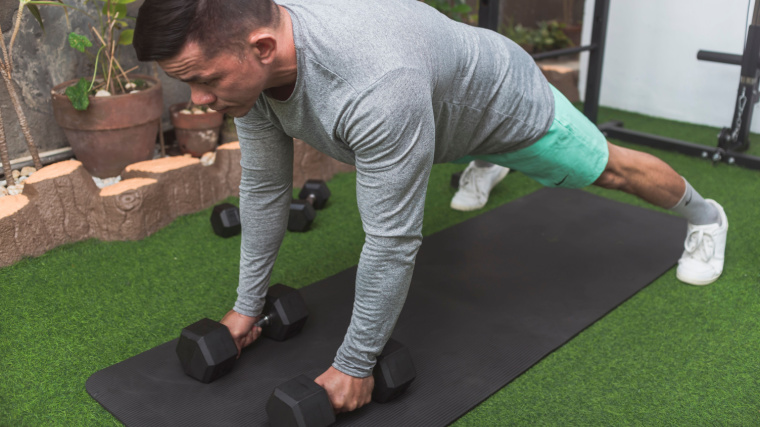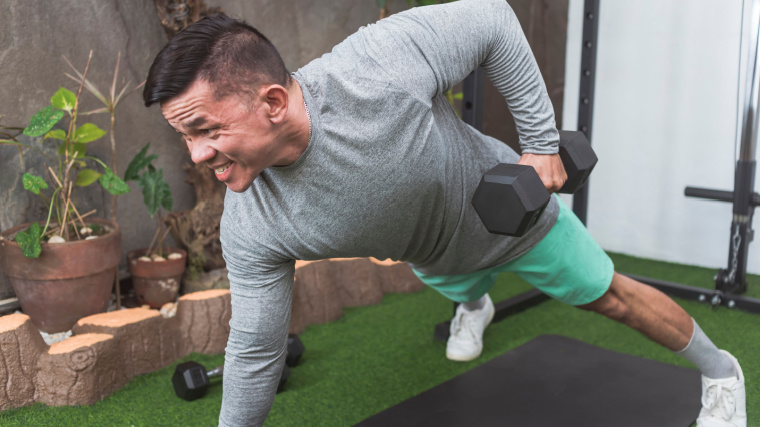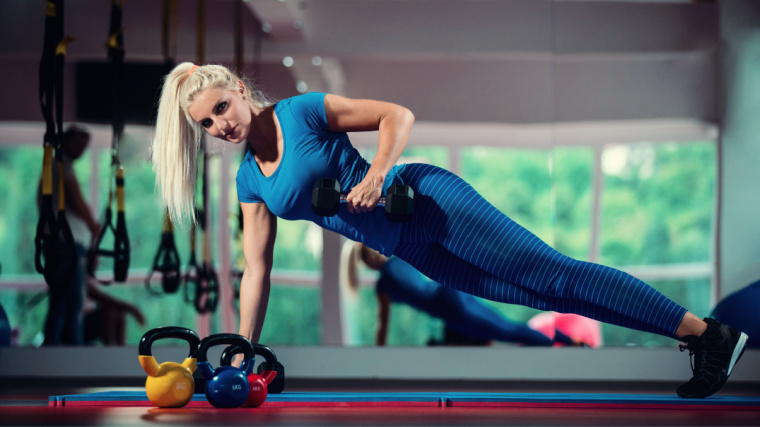The recent rise (and arguably unnecessary obsession) with “functional training” has seen the renegade row become a staple in CrossFit, fitness boot camps, and bodyweight workouts across the world.
It’s likely that many gym-goers or home-gym lifters have done this ground-based exercise at least a few times before — holding a straight-arm plank while performing alternating dumbbell rows — to build conditioning and head-to-toe strength and stability.

If you’re going to do the renegade row, it’s time to make sure you’re performing it properly. Here’s how and when to include it in your workout routine, plus a few effective variations to take this popular movement up a notch.
Renegade Row
- How to Do the Renegade Row
- Renegade Row Mistakes to Avoid
- How to Progress the Renegade Row
- Benefits of the Renegade Row
- Muscles Worked by the Renegade Row
- How to Program the Renegade Row
- Renegade Row Variations
- Frequently Asked Questions
How to Do the Renegade Row
The renegade row is a type of combination exercise — performing a static plank while simultaneously performing a rowing motion. So before you try the renegade row, you should have some basic experience performing both of those exercises separately. Then grab two dumbbells or kettlebells and get ready to work.
Step 1 — Set Your Hands and Feet

Get on the ground with a dumbbell in each hand, placed just inside shoulder-width. Set your feet slightly wider than hip-width and straighten your legs. Make sure you can really push into the ground with your feet, which will help you successfully create tension in your whole body. Don’t let your hips sag down or arch high. Hold a straight line from your ankles to your neck. This stable plank position is the “base” for each repetition of the exercise.
Form tip: Placing your hands directly under shoulders would be great technique for a standard plank, but remember this is not just a plank. Having your hands a bit closer is going to help your stability by reducing the weight transfer from side to side as you switch arms during each repetition. This will make it much easier to create tension in your plank while keeping your hips nearly level.
Step 2 – Press and Pull

Squeeze both dumbbells extra-hard and actively push one arm toward the ground without bending it. This will create more stability through your upper body. (1) As you drive that arm down, lift the opposite elbow up and back, moving the weight toward your front pocket in an arching motion, not in a straight line to the ceiling. Maintain total-body tension and fight the weight pulling you off-balance.
When the dumbbell is near your torso, return it back to the floor slowly. The exercise is about control and consistency, not rushing through reps as quickly as possible. Drive your second arm toward the ground and row the first dumbbell. Repeat the movement, alternating sides with each repetition.
Form tip: As you row your elbow up and back, it’s going to be tempting to lift that same side hip and shoulder because rotating your body might assist you with the lift. Instead, move toward the challenge, literally. If you are rowing on the right side, your body will naturally want to lift your right hip. Instead, as you pull your elbow up, actively push your right hip down to resist the twist and keep your hips level. This will also help you to stay more braced through your midsection and recruit more abdominal muscles.
Renegade Row Mistakes to Avoid
The exercise involves head-to-toe coordination and stability, so there are some common mistake that can occur with such a big movement. Here are some issues to watch out for.
Keeping Your Feet Too Close
When your feet are set too narrow, it will be nearly impossible to do anything other than simply shift your weight from side to side as you move through the rep. It’s extremely difficult to maintain a plank position because close feet create a very small base of support, so you end up just doing a row in a really inefficient position.

Keeping your feet set slightly wider than your hands will put you in a powerful stance to perform the movement without sacrificing stability. If your feet are too close, you’ll be off-balance from the start and unable to generate enough force to efficiently lift the dumbbell.
Avoid it: When you get into the starting position, make sure your feet are more than hip-width apart to provide a wide enough point of contact for stability. When you row, you shouldn’t be at risk of tipping to one side or the other.
Twisting Your Body
Rotating your body to get the weight moving means you’re using momentum to help pull the dumbbell off the floor instead of using your back muscles. When this happens, you end up with a very poor row and a very poor plank. That’s a lose-lose situation.

When you shift your body to one side, you drastically reduce the need to stabilize your core, which takes away from the entire point of the exercise. You might end up doing extra reps, but each rep is less effective at building strength and conditioning.
Avoid it: Try to focus on body awareness and feel your shoulders and hips staying nearly level throughout the entire exercise, as you lift and lower the weights. Fighting to keep your body in position is what’s going to deliver the results you’re after.
Tapping the Weight to Your Chest
When you’re performing the renegade row, focus on the movement of your elbow instead of what’s happening with the dumbbell itself. If your elbow starts and finishes in the right place, the dumbbell will follow.

When the load gets too heavy or when you focus on “bringing the dumbbell to your ribs,” you lose range of motion because the focus shifts away from the most effective technique.
Avoid it: Pay attention to each individual repetition and perform it properly, without regard to the specific weight you’re moving. Go step by step and follow the technique tips, and avoid any instinct to make the dumbbell a key player in the movement.
How to Progress the Renegade Row
Deciding how and when to progress this movement can be difficult and there need to be some special considerations because it is a combination we are not just progressing one movement.
Technique Over Weight or Volume
The renegade row isn’t well-suited for handling heavy weights, training with extreme intensities (muscle failure), or using high volume (many sets and reps). Instead, performing the exercise with greater competency and crisp form is the real key to long-term success and results.
Gradually adding even one or two reps per set, or one or two sets, each workout would give you a great opportunity to perform some very effective, high-quality work.
Plank Shoulder Tap
One modification to the renegade row is to swap the dumbbell row for an unweighted shoulder tap, reaching one arm across your body to lightly tough the shoulder of your base arm.
This bodyweight-only exercise trains similar total-body stability and strength by teaching you how to stay tight in a plank position while alternating between single-hand support. You’ll also build core strength to keep your body level and avoid twisting as you move.
Unilateral Renegade Row
Another effective modification the renegade row would be to do all reps unilaterally (with one arm) before switching arms. This creates more localized fatigue in the muscles on the specific side you’re working.
While the unilateral renegade row emphasizes the back muscles and core stability, it can be slightly less challenging rotationally because your body isn’t repeatedly adjusting from between alternating sides.
Benefits of the Renegade Row
The renegade row is not a great exercise choice for improving absolute strength because you can’t move heavy weights. It’s also not ideal for hypertrophy (muscle-building) because it doesn’t focus a specific body part with the time under tension needed to stimulate growth. (2) However, it can be an incredibly useful exercise to address often overlooked aspects of many training plans.
Core Control
The renegade row is a complete core exercise that can build strength and stability, while also improving your ability to move your upper body limbs around the rib cage. This carries over to athletic performance and big lifts.
A stronger core may help reduce the risk of back injuries and can boost performance, especially in sports where running and change of direction are involved. (3) Training your body to maintain trunk stability while manipulating your arms can be a big factor in avoiding “strength leaks,” which can reduce power output.
Strength-Endurance (aka Conditioning)
To perform the renegade row competently, you need to take your time with a relatively moderate to light load and moderate to higher repetitions because the exercise isn’t conducive to very heavy weights or very low reps.
The duration of each set creates a stimulus that is more endurance-based, which contributes to muscle-specific endurance in the recruited body parts (especially the back, shoulders, arms, and abs). The total-body exercise also contributed to overall cardiovascular endurance — after your first set of 15 or more reps, you’ll notice what kind of cardio shape you’re really in.
Muscles Worked by the Renegade Row
The combination of the plank position and single-arm row will recruit a large number of muscle groups across the body, even though the renegade row is sometimes considered either an ab exercise or a back exercise.
Internal Obliques
These deep core muscles are responsible for controlling your pelvis and creating posterior tilt, along with the hamstrings. The internal obliques help you to create and maintain tension with the other core muscles, like the transverse abdominals and the rectus abdominis. They also work significantly to resist rotation when you raise the dumbbell on either side during the renegade row.
Chest, Shoulders, and Triceps
These muscles work together during the exercise, as they are recruited in an isometric action (without any significant range of motion) as you push into the ground and keep the arms fully extended. The chest, shoulders, and triceps of your base arm fire as you row the opposite side, although the rear portion of the shoulder on the working side also assists to lift the weight.
Lats, Rhomboids, and Trapezius
This series of separate back muscles work together to put the row in “renegade row.” They are recruited during the concentric (lifting) action and they control the weight back to the ground during the eccentric (lowering) phase.
Depending on your arm length and range of motion, not all of the muscles may achieve the type of full stretch and peak contraction that contribute to major muscle growth.
How to Program the Renegade Row
The renegade row is often performed either as a standalone exercise or as part of a complex with other bodyweight or basic dumbbell exercises. It is essentially a core exercise, and fits well at either the beginning of a workout (similar to a full-body warm-up to improve movement quality) or at the end of a workout as a high intensity core finisher.
Light to Moderate Weight, Moderate to High Repetition
To maintain an emphasis on strict technique, stick with a weight that’s challenging for no fewer than 8-10 reps — if you go much heavier than that, you’re likely to compromise form to move the weight. Generally, training the renegade row with two or three sets of 12 to 20 reps can deliver a major stimulus for conditioning and muscular stimulation.
Movement Quality
One unique way to incorporate the renegade row at the start of your workout is with a quick circuit, pairing the exercise with two or three core-focused bodyweight movements. Perform three to five sets of the entire sequence, with no rest between each exercise and 30 to 60 seconds rest between each circuit.
- Renegade Row — 10 reps
- Deadbug — 10 reps
- Side Plank — 30 seconds per side
- Medicine Ball Throw — 10 reps
Core Finisher
You can also end your training session with a finisher that features the renegade row and emphasizes the abs. Repeat the series for as many rounds as possible within five minutes.
- Renegade Row — 10 reps
- Leg Raise — 10 reps
- Sit-Up — 10 reps
- Hollow Hold — 20 seconds
Renegade Row Variations
The renegade row can be pretty complete on its own, but there are a few variations that can take it even further. By adding the right movements to the basic renegade row, you can get more muscle recruitment and a bigger overall training stimulus.
Renegade Row Push-Up
One of the most challenging renegade row variations involves adding a push-up between each row. Special consideration needs to be taken here because now you need to be highly competent at three different exercises (the plank, dumbbell row, and push-up), so it’s definitely not a beginners-level movement.
This variation works very well as part of a circuit with two or three other exercises, such as mountain climbers and the dumbbell deadlift, where the renegade row could be performed with lower reps but repeated for more total sets.
Renegade Row Burpee
The burpee itself has a strong “love it or hate it” reputation with many lifters, but it can flow smoothly at the end of a renegade row because the plank also the bottom position of a burpee.
Transitioning from the renegade row to the burpee can either be done with a quick and seamless transition, for a high intensity conditioning effect, or you can briefly pause in the plank position after the second row before jumping your feet in. This can help prevent form breakdown.
FAQs
Yes, you can build a degree of strength, but it’s technically relative strength rather than absolute strength. Meaning, it will get you generally stronger overall, but not necessarily closer to doing barbell rows with 300 pounds.
Similar to doing air squats compared to barbell squats, you will see some improvements in strength and work capacity (conditioning), but those improvements will be relative to the load and intensity you can use during the exercise. With the renegade row, load and intensity are limiting factors — you can’t train with heavy weights and you can’t safely reach muscular failure.
Regardless, you can definitely include the exercise in your routine and benefit from improved relative strength, but if getting super-strong is a priority, focus on improving absolute strength with heavy weights and low reps with exercises deadlifts, rows, and pull-ups.
This is actually very common. The simplest solution is to place your hands on the floor, with the dumbbells just inside your wrists. Then, only pick the dumbbell up when performing the rowing portion of the rep. Each repetition will take slightly longer and you might not be able to do as many reps, but it will still be an effective core exercise.
Be a Renegade
The renegade row is definitely not for beginning lifters because there are so many moving parts. Once you’re mastered form on the component exercises like the plank, dumbbell row, and even push-ups, then you’re ready to add this full-body exercise to your program and start building rock-solid stability and off-the-charts conditioning.
References
- Gontijo, L. B., Pereira, P. D., Neves, C. D., Santos, A. P., Machado, D.deC., & Bastos, V. H. (2012). Evaluation of strength and irradiated movement pattern resulting from trunk motions of the proprioceptive neuromuscular facilitation. Rehabilitation research and practice, 2012, 281937. https://ift.tt/YwLQ9Dg
- Burd, N. A., Andrews, R. J., West, D. W., Little, J. P., Cochran, A. J., Hector, A. J., Cashaback, J. G., Gibala, M. J., Potvin, J. R., Baker, S. K., & Phillips, S. M. (2012). Muscle time under tension during resistance exercise stimulates differential muscle protein sub-fractional synthetic responses in men. The Journal of physiology, 590(2), 351–362. https://ift.tt/fVtRClB
- McGill, Stuart PhD. Core Training: Evidence Translating to Better Performance and Injury Prevention. Strength and Conditioning Journal 32(3):p 33-46, June 2010. | DOI: 10.1519/SSC.0b013e3181df4521
Featured Image: MDV Edwards / Shutterstock
The post How to Do the Renegade Row for Conditioning and Core Strength appeared first on Breaking Muscle.
from Breaking Muscle https://ift.tt/iOB2Vq3
via IFTTT
